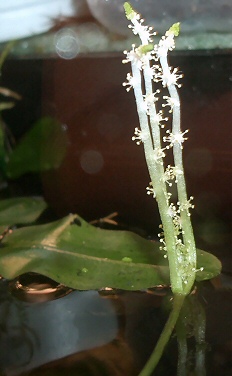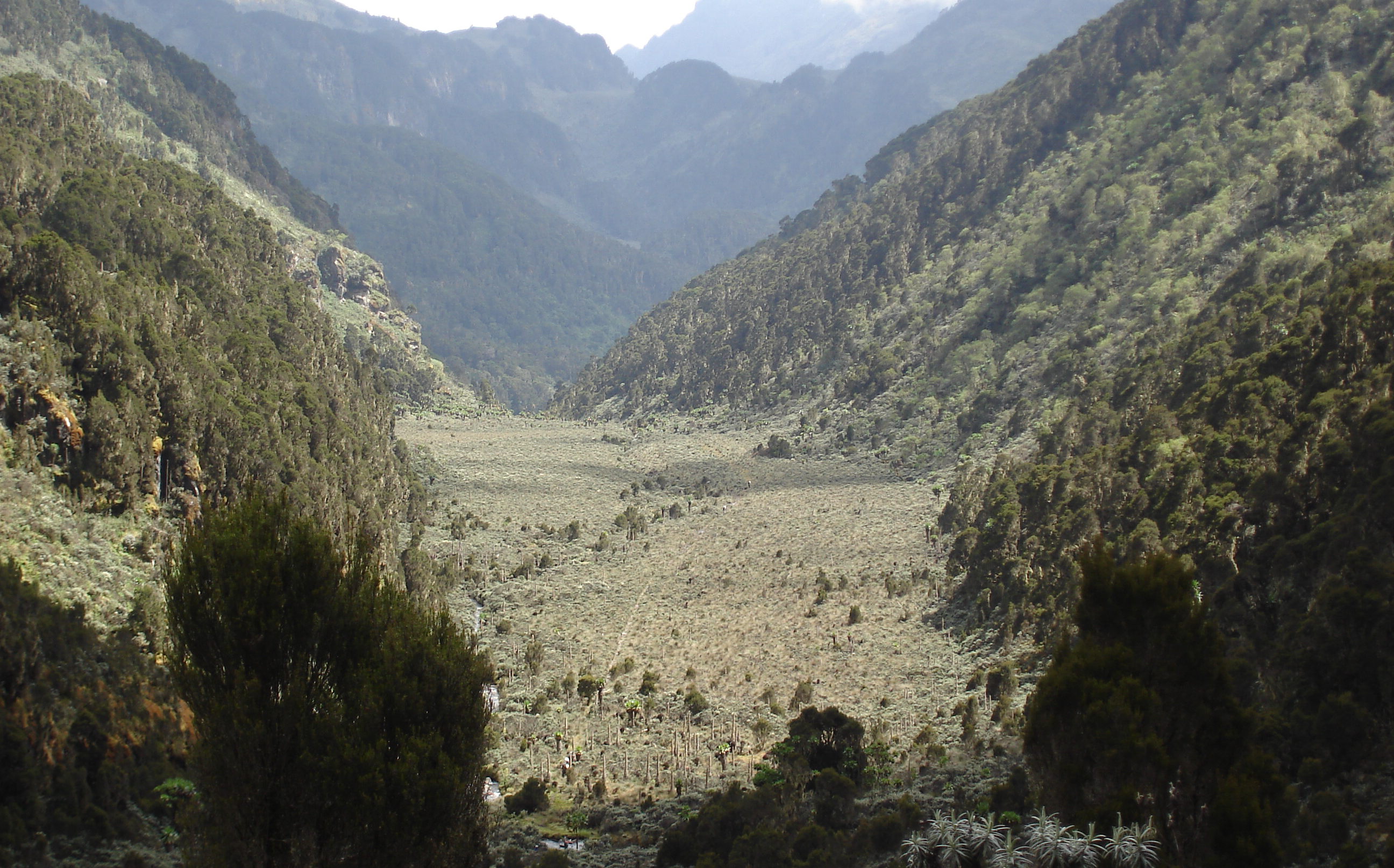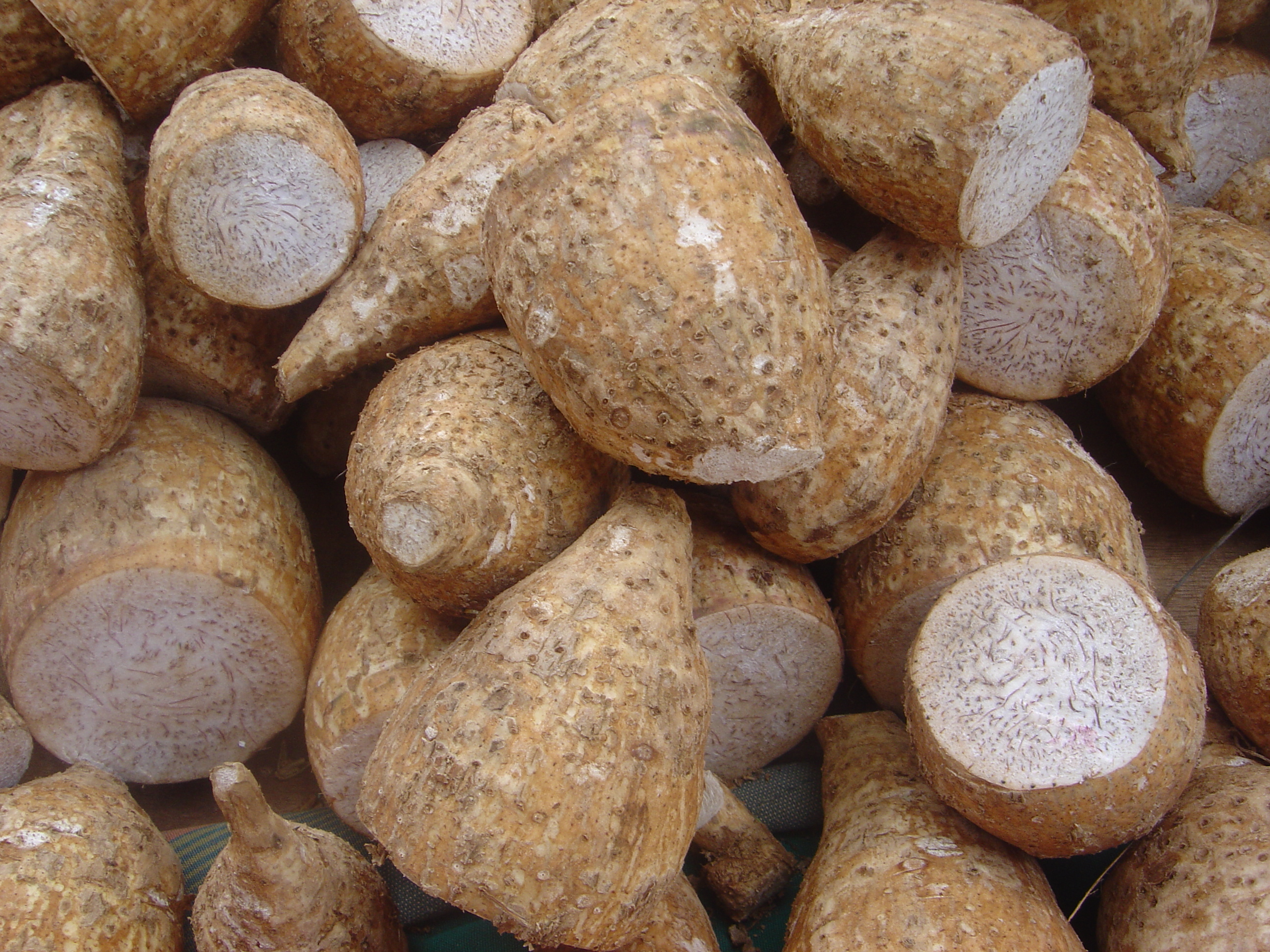|
Aponogeton Ranunculiflorus
''Aponogeton ranunculiflorus'', the Sehlabathebe water lily, is a tiny and endangered species of aquatic plant, that belongs to the pondweed family Aponogetonaceae. It is protected in the Sehlabathebe National Park in the mountains of Lesotho, where it is very localized, and nearby in the uKhahlamba / Drakensberg Park of KwaZulu-Natal, South Africa. Outside these areas it is seriously threatened. It is found in sandstone rock pools, up to 7 metres deep, and in permanently wet tarns or sensitive high altitude mires, at altitudes between about 2,600 and 3,200 metres. Its spiralled stems allow the flowers to remain at surface level. Threats to the species include overgrazing and trampling by cattle, overburning, erosion and subsistence farming. Their small (1 cm) corms A corm, bulbo-tuber, or bulbotuber is a short, vertical, swollen underground plant stem that serves as a storage organ that some plants use to survive winter or other adverse conditions such as summer drought a ... [...More Info...] [...Related Items...] OR: [Wikipedia] [Google] [Baidu] |
Amy Jacot Guillarmod
Amy Frances May Gordon Jacot Guillarmod (née Hean) (23 May 1911 – 1992), was a South African botanist and limnologist, noted for her work on the flora of Basutoland and some 200 publications, including numerous papers on wetlands, bogs and sponges. Education and academic career She matriculated at the Durban Girls' High School, leaving for Edinburgh shortly after. Jacot Guillarmod was awarded an MA in English and History at the University of St Andrews, but inspired by D'Arcy Wentworth Thompson, switched interests and started an MSc degree in Botany and Zoology at the same university. On her return to South Africa, she taught briefly in Durban and was then appointed plant pathologist in the ''Division of Botany and Plant Pathology'' of the Department of Agriculture in Pretoria. Her first papers dealt with the viral diseases of tobacco and other crops. She spent the years between 1940 and 1957 in Basutoland. In 1956/7 she became Head of the Botany Department of the Pius XI ... [...More Info...] [...Related Items...] OR: [Wikipedia] [Google] [Baidu] |
Aponogetonaceae
The Aponogetonaceae (the Cape-pondweed family or aponogeton family) are a family of flowering plants in the order Alismatales. In recent decades the family has had universal recognition by taxonomists. The APG system (1998) and APG II system (2003) treat it in the order Alismatales in the clade monocots. The family consists of only one genus, ''Aponogeton'', with 56 known species (Christenhusz & Byng 2016 ) of aquatic plants, most of which have been included in a molecular phylogeny by Chen et al. (2015). The name was published in '' Supplementum Plantarum'' 32: 214 (1782) and is derived from a geographic location neighboring (''geton'') the Apono tribal district of coastal Gabon. Some species are used as ornamental plants in aquariums. Distribution They are aquatic plants, which are found in tropical to warm temperate regions of Africa, Asia and Australasia.Watson, L. & Dallwitz, M. J. (1992 onwards)Aponogetonaceae ''Aponogeton distachyos'' is originally from South Africa but h ... [...More Info...] [...Related Items...] OR: [Wikipedia] [Google] [Baidu] |
Sehlabathebe National Park
The Sehlabathebe National Park is located in the Maloti Mountains in Qacha's Nek District, Lesotho and is part of the Maloti-Drakensberg World Heritage Site. The park was first established on May 8. 1969 and since then, it is recognized important in terms of biological diversity and cultural heritage. The landscape is dominated by a grassland of various types. The larger ecosystem functions provide freshwater to Lesotho, South Africa, and Namibia. Location Sehlabathebe National Park is situated in the south-east corner of Lesotho at an average elevation of some 2,400 metres above sea level. Environment Most of the park is taken up by a designated wilderness area, and is uninhabited. Much of it consists of cliffs, waterfalls, pools, rock dwellings and rock art. It is known for its scenery with unique rock formations. The Tsoelikanyane waterfall is the biggest waterfall in the park. A total of 65 rock art sites have been identified in the area, as well as other forms of the pr ... [...More Info...] [...Related Items...] OR: [Wikipedia] [Google] [Baidu] |
Lesotho
Lesotho ( ), officially the Kingdom of Lesotho, is a country landlocked as an enclave in South Africa. It is situated in the Maloti Mountains and contains the highest mountains in Southern Africa. It has an area of over and has a population of about million. It was previously the British Crown colony of Basutoland, which declared independence from the United Kingdom on 4 October 1966. It is a fully sovereign state and is a member of the United Nations, the Commonwealth of Nations, the African Union, and the Southern African Development Community. The name ''Lesotho'' roughly translates to "land of the Sotho". History Basutoland Basutoland emerged as a single polity under King Moshoeshoe I in 1822. Moshoeshoe, a son of Mokhachane, a minor chief of the Bakoteli lineage, formed his own clan and became a chief around 1804. Between 1820 and 1823, he and his followers settled at the Butha-Buthe Mountain, joining with former adversaries in resistance against the ... [...More Info...] [...Related Items...] OR: [Wikipedia] [Google] [Baidu] |
UKhahlamba / Drakensberg Park
The uKhahlamba-Drakensberg Park is a protected area in the KwaZulu-Natal province of South Africa, covering , and is part of a world heritage site. The park includes Royal Natal National Park, a provincial park, and covers part of the Drakensberg, an escarpment formation with the highest elevations in southern Africa. The park and the adjoining Sehlabathebe National Park in the Kingdom of Lesotho are part of the Maloti-Drakensberg Park, which was first declared a World Heritage Site on 30 November 2000. It is described by UNESCO as having "exceptional natural beauty in its soaring basaltic buttresses, incisive dramatic cutbacks, and golden sandstone ramparts... the site’s diversity of habitats protects a high level of endemic and globally threatened species, especially birds and plants... nd italso contains many caves and rock-shelters with the largest and most concentrated group of paintings in Africa south of the Sahara". The paintings mentioned are parietal art, some of w ... [...More Info...] [...Related Items...] OR: [Wikipedia] [Google] [Baidu] |
KwaZulu-Natal
KwaZulu-Natal (, also referred to as KZN and known as "the garden province") is a province of South Africa that was created in 1994 when the Zulu bantustan of KwaZulu ("Place of the Zulu" in Zulu) and Natal Province were merged. It is located in the southeast of the country, with a long shoreline on the Indian Ocean and sharing borders with three other provinces and the countries of Mozambique, Eswatini and Lesotho. Its capital is Pietermaritzburg, and its largest city is Durban. It is the second-most populous province in South Africa, with slightly fewer residents than Gauteng. Two areas in KwaZulu-Natal have been declared UNESCO World Heritage Sites: the iSimangaliso Wetland Park and the uKhahlamba Drakensberg Park. These areas are extremely scenic as well as important to the surrounding ecosystems. During the 1830s and early 1840s, the northern part of what is now KwaZulu-Natal was established as the Zulu Kingdom while the southern part was, briefly, the Boer Nata ... [...More Info...] [...Related Items...] OR: [Wikipedia] [Google] [Baidu] |
South Africa
South Africa, officially the Republic of South Africa (RSA), is the southernmost country in Africa. It is bounded to the south by of coastline that stretch along the South Atlantic and Indian Oceans; to the north by the neighbouring countries of Namibia, Botswana, and Zimbabwe; and to the east and northeast by Mozambique and Eswatini. It also completely enclaves the country Lesotho. It is the southernmost country on the mainland of the Old World, and the second-most populous country located entirely south of the equator, after Tanzania. South Africa is a biodiversity hotspot, with unique biomes, plant and animal life. With over 60 million people, the country is the world's 24th-most populous nation and covers an area of . South Africa has three capital cities, with the executive, judicial and legislative branches of government based in Pretoria, Bloemfontein, and Cape Town respectively. The largest city is Johannesburg. About 80% of the population are Black Sou ... [...More Info...] [...Related Items...] OR: [Wikipedia] [Google] [Baidu] |
Tarn (lake)
A tarn (or corrie loch) is a proglacial mountain lake, pond or pool, formed in a cirque excavated by a glacier. A moraine may form a natural dam below a tarn. Etymology The word is derived from the Old Norse word ''tjörn'' ("a small mountain lake without tributaries") meaning pond. In parts of Northern England - predominantly Cumbria but also areas of North Lancashire and North Yorkshire - 'tarn' is widely used as the name for small lakes or ponds, regardless of their location and origin (e.g. Talkin Tarn, Urswick Tarn, Malham Tarn). Similarly, in Scandinavian languages, a ''tjern'' or ''tjørn'' (both Norwegian) or ''tjärn'' or ''tärn'' (both Swedish) is a small natural lake, often in a forest or with vegetation closely surrounding it or growing into the tarn. The specific technical use for a body of water in a glacial corrie comes from high number of tarns found in corries in the Lake District, an upland area in Cumbria. Nonetheless, there are many more bodies of water ... [...More Info...] [...Related Items...] OR: [Wikipedia] [Google] [Baidu] |
Mire
A mire, peatland, or quagmire is a wetland area dominated by living peat-forming plants. Mires arise because of incomplete decomposition of organic matter, usually litter from vegetation, due to water-logging and subsequent anoxia. All types of mires share the common characteristic of being saturated with water, at least seasonally with actively forming peat, while having their own ecosystem. Like coral reefs, mires are unusual landforms that derive mostly from biological rather than physical processes, and can take on characteristic shapes and surface patterning. A quagmire is a floating (quaking) mire, bog, or any peatland being in a stage of hydrosere or hydrarch (hydroseral) succession, resulting in pond-filling yields underfoot. Ombrotrophic types of quagmire may be called quaking bog (quivering bog). Minerotrophic types can be named with the term quagfen. There are four types of mire: bog, fen, marsh and swamp. A bog is a mire that, due to its location relative to the s ... [...More Info...] [...Related Items...] OR: [Wikipedia] [Google] [Baidu] |
Overgrazing
Overgrazing occurs when plants are exposed to intensive grazing for extended periods of time, or without sufficient recovery periods. It can be caused by either livestock in poorly managed agricultural applications, game reserves, or nature reserves. It can also be caused by immobile, travel restricted populations of native or non-native wild animals. Overgrazing reduces the usefulness, productivity, and biodiversity of the land and is one cause of desertification and erosion. Overgrazing is also seen as a cause of the spread of invasive species of non-native plants and of weeds. Degrading land, emissions from animal agriculture and reducing the biomass in a ecosystem contribute directly to climate change. Overgrazing can be reversed or prevented by removing grazers in order to give plants time to recover between grazing events. Successful planned grazing strategies have been support in the American bison of the Great Plains, or migratory Wildebeests of the Africa ... [...More Info...] [...Related Items...] OR: [Wikipedia] [Google] [Baidu] |
Corms
A corm, bulbo-tuber, or bulbotuber is a short, vertical, swollen underground plant stem that serves as a storage organ that some plants use to survive winter or other adverse conditions such as summer drought and heat (perennation). The word ''cormous'' usually means plants that grow from corms, parallel to the terms ''tuberous'' and ''bulbous'' to describe plants growing from tubers and bulbs. Structure A corm consists of one or more internodes with at least one growing point, generally with protective leaves modified into skins or tunics. The tunic of a corm forms from dead petiole sheaths—remnants of leaves produced in previous years. They act as a covering, protecting the corm from insects, digging animals, flooding, and water loss. The tunics of some species are thin, dry, and papery, at least in young plants, however, in some families, such as ''Iridaceae'', the tunic of a mature corm can be formidable protection. For example, some of the larger species of '' Wats ... [...More Info...] [...Related Items...] OR: [Wikipedia] [Google] [Baidu] |
Aponogeton
The Aponogetonaceae (the Cape-pondweed family or aponogeton family) are a family of flowering plants in the order Alismatales. In recent decades the family has had universal recognition by taxonomists. The APG system (1998) and APG II system (2003) treat it in the order Alismatales in the clade monocots. The family consists of only one genus, ''Aponogeton'', with 56 known species (Christenhusz & Byng 2016 ) of aquatic plants, most of which have been included in a molecular phylogeny by Chen et al. (2015). The name was published in ''Supplementum Plantarum'' 32: 214 (1782) and is derived from a geographic location neighboring (''geton'') the Apono tribal district of coastal Gabon. Some species are used as ornamental plants in aquariums. Distribution They are aquatic plants, which are found in tropical to warm temperate regions of Africa, Asia and Australasia.Watson, L. & Dallwitz, M. J. (1992 onwards)Aponogetonaceae ''Aponogeton distachyos'' is originally from South Africa ... [...More Info...] [...Related Items...] OR: [Wikipedia] [Google] [Baidu] |

.jpg)


